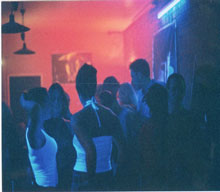What is Chemiluminescence?
Chemiluminescence is the production of light from a chemical reaction
in excess of the black body radiation expected from that body. As such,
it is often referred to as “cold light”.
Normally, chemiluminescence involves the production of an electronically
excited species from a number of reactants which goes on to release visible
light in order to revert to its ground state energy.
Applications of Chemiluminescence
- Pharmaceutical Industry (analysis and quality control)
- Clinical Science
- Alumina Industry
- Forensics
- Detecting the photoactivity of water through its H2O2 Concentration.
- Detecting Nitric Oxide in the breath of Asthma Patients.
- HPLC (High Performance Liquid Chromatography)
- This has nothing to do with
luminol but has to be seen!
The Difference Between Fluorescence, Phosphorescence and Chemiluminescence
There are three main types of “cold light” reactions in chemistry
which are often confused but are in fact very different. It is important
to make sure that you know the difference.
Fluorescence
You have probably covered this in your course. Here higher energy radiation
is absorbed by a species and stored for long enough that the molecules
have collided and lost vibrational energy in collisions. When the excited
molecule re-emits, the photon is of less energy depending on the species
and is therefore of a lower frequency.
A good example of this phenomena is your white clothes. Detergent manufacturers
put fluorescers in with their mixture to make your clothes really “whiter
than white” as they absorb UV radiation in sunlight and emit it
in the visible region causing the net light reflected from your clothes
to be higher than expected. The same fluorescers are to blame for your
white clothes glowing blue under UV lights as the re-emitted wavelength
falls in the blue portion of the spectrum. Note that Fluorescence is normally
emitting from a singlet state whereas phosphorescence
(below) occurs from triplet states.
Phosphorescence
 Here
light is absorbed by a molecule which becomes excited to a higher singlet
state. The light can either be re-emitted straight away or (very-rarely),
the electron can switch to a triplet state
(this is technically forbidden but can happen often enough through a process
known as intersystem crossing). Transitions between different multiplicities
are forbidden by quantum selection rules and as the ground state of the
molecule will often be a singlet state (recall
all closed shells are singlets), the molecule is not allowed to emit a
photon that will get it directly to the ground state. The molecule must
wait a long time (in quantum chemistry) until it can make the forbidden
transition. Here
light is absorbed by a molecule which becomes excited to a higher singlet
state. The light can either be re-emitted straight away or (very-rarely),
the electron can switch to a triplet state
(this is technically forbidden but can happen often enough through a process
known as intersystem crossing). Transitions between different multiplicities
are forbidden by quantum selection rules and as the ground state of the
molecule will often be a singlet state (recall
all closed shells are singlets), the molecule is not allowed to emit a
photon that will get it directly to the ground state. The molecule must
wait a long time (in quantum chemistry) until it can make the forbidden
transition.
Chemiluminescence
 The
mechanism for this reaction is outlined extensively throughout this site
but the key difference to note is that no radiation is absorbed –
the energy required to emit light comes from the energetics of the chemical
reaction. The emission could proceed either from a singlet
(fluorescence) or triplet (phosphorescence)
state. "Light Sticks" are a popular example of Chemiluminescence. The
mechanism for this reaction is outlined extensively throughout this site
but the key difference to note is that no radiation is absorbed –
the energy required to emit light comes from the energetics of the chemical
reaction. The emission could proceed either from a singlet
(fluorescence) or triplet (phosphorescence)
state. "Light Sticks" are a popular example of Chemiluminescence.
|

